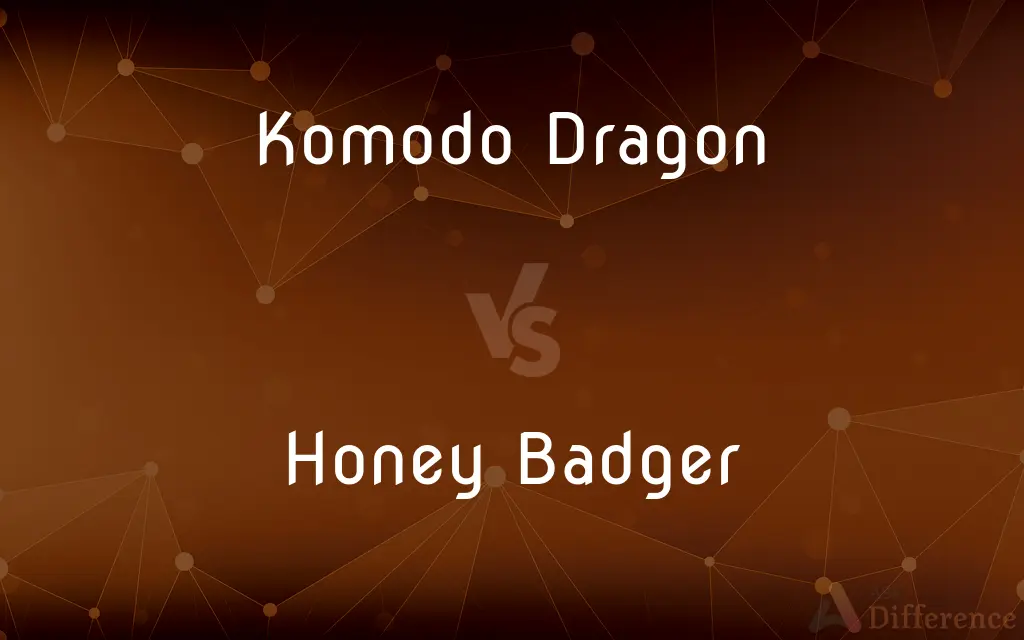Komodo Dragon vs. Honey Badger — What's the Difference?
Edited by Tayyaba Rehman — By Fiza Rafique — Published on December 27, 2023
Komodo Dragon is a large monitor lizard from Indonesia; Honey Badger is a small, fearless mammal native to Africa and Asia.

Difference Between Komodo Dragon and Honey Badger
Table of Contents
ADVERTISEMENT
Key Differences
The Komodo Dragon is the largest living lizard on Earth, primarily found on the Indonesian islands, including Komodo. In contrast, the Honey Badger is a small, tenacious mammal predominantly spotted across Africa, Southwest Asia, and the Indian subcontinent.
Physically, Komodo Dragons can reach lengths of up to 10 feet and weigh more than 150 pounds. Honey Badgers, being much smaller, typically measure up to 28 inches in body length and weigh around 30 pounds, displaying a stark size disparity between the two creatures.
Komodo Dragons are carnivorous reptiles known for their formidable hunting skills, often preying on larger animals. Honey Badgers, though also carnivorous, have a varied diet that includes insects, fruits, and honey, showcasing their adaptability in different environments.
In terms of defense mechanisms, the Komodo Dragon relies on its sharp claws, powerful bite, and venomous saliva to deter threats. On the other hand, Honey Badgers are famously fearless and aggressive, using their sharp teeth, strong claws, and thick skin to fend off predators.
While Komodo Dragons are solitary creatures that dominate their habitats, often at the top of their food chain, Honey Badgers are known for their audacity, willing to confront animals much larger than themselves, underlining their reputation for being one of the most fearless animals in the world.
ADVERTISEMENT
Comparison Chart
Classification
Reptile
Mammal
Habitat
Indonesian islands
Africa, Southwest Asia, Indian subcontinent
Physical Size
Up to 10 feet in length
Up to 28 inches in body length
Diet
Mainly carnivorous
Varied - insects, fruits, honey, and more
Notable Characteristics
Venomous saliva, powerful bite
Fearless, aggressive, thick skin
Compare with Definitions
Komodo Dragon
Carnivorous with formidable hunting skills.
The prey of a Komodo Dragon can range from birds to larger mammals.
Honey Badger
Has a varied diet including honey.
The Honey Badger often raids beehives to savor honey.
Komodo Dragon
Indigenous to Indonesian islands.
Komodo Island is a famous habitat of the Komodo Dragon.
Honey Badger
Thick-skinned and resistant to venom.
A Honey Badger can withstand snake bites due to its thick skin.
Komodo Dragon
Solitary and dominant in its habitat.
Komodo Dragons are often found alone, ruling their terrain.
Honey Badger
Known for its audacious nature.
The Honey Badger's bravery is legendary in the animal kingdom.
Komodo Dragon
Largest living lizard species.
The Komodo Dragon's immense size is a wonder to behold.
Honey Badger
Found across Africa and parts of Asia.
The Honey Badger's adaptability is seen in its widespread habitat.
Komodo Dragon
Possesses venomous saliva.
A bite from a Komodo Dragon can be deadly due to its venomous saliva.
Honey Badger
A small yet fearless mammal.
Despite its size, the Honey Badger often confronts larger predators.
Common Curiosities
Where is the Komodo Dragon primarily found?
The Komodo Dragon is native to several Indonesian islands, including Komodo.
How big can a Komodo Dragon get?
Komodo Dragons can reach lengths of up to 10 feet.
What does a Honey Badger primarily eat?
Honey Badgers have a varied diet, including insects, fruits, and honey.
Is the Honey Badger really as fearless as it's portrayed?
Yes, Honey Badgers are known for their audacity and willingness to confront larger animals.
Are Komodo Dragons venomous?
Yes, Komodo Dragons have venomous saliva which can be deadly to their prey.
Do Honey Badgers attack humans?
While they usually avoid humans, Honey Badgers can be aggressive if provoked.
How does the Honey Badger defend itself?
Honey Badgers use their sharp teeth, strong claws, and thick skin to fend off threats.
Are Komodo Dragons endangered?
Yes, Komodo Dragons are listed as vulnerable due to habitat loss and other factors.
Is the Honey Badger a type of badger?
Yes, but it's the only species in its genus and has distinct characteristics.
Why is the Honey Badger so resistant to venom?
Honey Badgers have evolved a certain resistance, thanks to their thick skin and specialized metabolism.
How do Komodo Dragons hunt their prey?
They use a combination of stealth, power, and their venomous bite.
Why are Honey Badgers often associated with honey?
They have a fondness for honey and often raid beehives, earning their name.
Which is larger, the Komodo Dragon or the Honey Badger?
The Komodo Dragon is much larger than the Honey Badger.
What's the primary threat to Komodo Dragons?
Habitat loss and human encroachments are significant threats to Komodo Dragons.
How fast can a Komodo Dragon run?
A Komodo Dragon can run up to 12 miles per hour in short bursts.
Share Your Discovery

Previous Comparison
Microsoft Word vs. Wordpad
Next Comparison
Wild Type vs. MutantAuthor Spotlight
Written by
Fiza RafiqueFiza Rafique is a skilled content writer at AskDifference.com, where she meticulously refines and enhances written pieces. Drawing from her vast editorial expertise, Fiza ensures clarity, accuracy, and precision in every article. Passionate about language, she continually seeks to elevate the quality of content for readers worldwide.
Edited by
Tayyaba RehmanTayyaba Rehman is a distinguished writer, currently serving as a primary contributor to askdifference.com. As a researcher in semantics and etymology, Tayyaba's passion for the complexity of languages and their distinctions has found a perfect home on the platform. Tayyaba delves into the intricacies of language, distinguishing between commonly confused words and phrases, thereby providing clarity for readers worldwide.














































